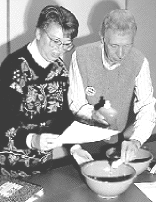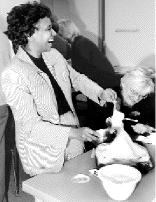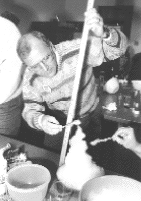"Inquiry into authentic questions generated from student experience is the central strategy for teaching science." -National Science Education Standards
|
Recognizing
Inquiry:
Comparing
Three
Hands-On
Teaching
Techniques
|
|||||||||
|
Inquiry teaching often involves the use of interactive, or hands-on, activities. Different types of hands-on activities can all be valuable in science learning, but don't necessarily indicate that inquiry is taking place. By comparing three styles of instruction, this chapter gives readers a feeling for how different hands-on methods can lead to different educational results. "We have adopted an inquiry-based curriculum to meet our world-class, inquiry-based standards." -School District Administrator "Our kits are full of inquiry lessons with student worksheets to accompany each of them." -Curriculum Company Salesperson
Today, we use this exercise in workshops designed to help teachers and school administrators experience and reflect on the inquiry process. This exercise not only gives these teaching professionals information about how to best use different kinds of hands-on instruction, it also gives them some insight into the learning process as they experience the same feelings of optimism, frustration, competitiveness, and potential for learning their students feel in each of these situations. During a typical Foam Workshop, I can watch these different situations unfold... Room 1: Guided Activity In Room 1, participants working on the guided activity each have a worksheet with instructions and clear expectations about what they need to accomplish. The activity asks participants to mix detergent and water in two different bowls, beat one bowl 200 strokes and the other 600 strokes, and then compare the results in a series of simple experiments. Walking into the room, I see that the instructor is just completing the brief directions: "Work in teams of two," she says. "Make sure you read the instructions carefully. Send one person from your group up to get the materials. You have 20 minutes to complete the activity and fill out your sheet. Begin." Some students begin to read their instructions while their partners go to collect the materials. The teams begin whipping their soap foam with eggbeaters, as instructed, and carrying out the required trials. What they are supposed to be doing seems very clear to all. Most groups seem very focused on getting through the worksheet. I can see some people checking the clock frequently to make sure they finish in the allotted time. There is little conversation in this room. These are good students and mainly "on task." I hear exchanges like this: Doreen: "What are we supposed to do next?" Angela: "It says we have to support these sticks in the foam." Doreen: "Okay. Let's start with the smallest one." Much of the discussion is like this, tending to be centered on how to complete the task at hand. On the other hand, I also hear conversation of a different sort. From the corner I hear, "Did you see what Maureen is wearing? I wonder where she got that?" This is an indication of a team coasting along and losing interest. From another team I hear, "I don't get it. Are we supposed to be learning that bigger bubbles make weaker foam? I see big bubbles in both of our mixes. This doesn't make sense." The instructor overhears this and comes by to try to steer them back on track, but I detect some lingering skepticism when she leaves. Toward the end of the allotted time, most groups are feeling good about completing their activities. But one last group is rushing to complete their work. From them I hear, "I don't know what was wrong with our stuff. Everyone else seemed to get a lot more foam. Well, let's see if we can figure out how to finish up anyway." There is a feeling of failure in those words. Finally, time is called. The teacher checks the worksheets to make sure everyone got the right answers. Each team gets a chance to compare two different foams in prescribed ways, and all team members leave having had a common experience. Room 2: Challenge Activity I drift over to Room 2, where a new round of the challenge activity is starting up. These students had just been told that, working in pairs, they are to build a 12-inch-high tower of foam. They seem very clear on the assigned objective, but the method for meeting this challenge is up to them to find. Right from the beginning, this room feels more lively than the one I just left. Hand-beaters and electric mixers are whirring like mad, making big bowls of soap foam. Some folks are starting to pile the foam onto plastic plates. All seem very engaged in the activity. One group's strategy seems to be to make the thickest, densest foam they can. "Thick foam is strongest," Tracy says. "It's the only thing that can hold up such a tall tower." But as they work, they see that the base of their tower keeps flowing out from underneath, and they ponder changing their approach. Another group asks the teacher for a whisk, which she rounds up for them. Jim says, "Whisks whip more air into our bubbles. I think airy bubbles will be easier to support." They continue to work hard with their whisk, but get very little foam with which to build. As time goes by, the anxiety level in the room mounts. Only a few groups are getting near the goal and all are hurrying to make it before time runs out. Michael's group is almost done. "Quick, come over and measure ours. I think we've got it!" The teacher comes over and measures the height of their foam tower. "Just half an inch more," she encourages. Michael adds a bit of light foam at the top. "You've got it," says the teacher. The group breaks out in a cheer. "We're number one! We're number one!" Some of the other students look defeated. Others redouble their efforts on their own towers. As the groups continue to work, the teacher walks around, making suggestions and reminding participants about the rules. One group begins to make more noise as they excitedly get close to their goal. But something looks wrong. The teacher pokes her finger into their tower and finds an upside-down cup inside. "That's cheating." she says. "You're supposed to be building a soap tower, not a soap-and-cup tower." The group looks a bit sheepish but continues on. Good science inquiry involves learning through direct interaction with materials and phenomena. A second group meets the challenge. They and the first group are now competing to build the tallest tower. Meanwhile, as time comes to an end, all the other groups still have not met the challenge. Over in the corner, I hear Joe say, "This isn't fair. The next group coming in will have had some practice with foam. We didn't have any." Sure enough, when I check in later with the group that did the open exploring before they did the challenge, the rate of success is considerably higher. The teacher tries to address Joe's concern, explaining that it is not building the tallest tower that is important, but what you learn while trying to do so. Still, one participant from a failed group says, "I should have expected this. I never could do science anyway." Room 3: Open Exploration Next, I walk into Room 3, where the open exploration activity is going on, and there I encounter a very different setup. The teacher has just completed a whole-group discussion in which the students have brainstormed a list of all the foams they know. She is pointing out, in detail, the primary materials with which students can work. Most of the materials are located on a main supply table; additional materials for other questions that may arise are located on a secondary table. The teacher says, "Working in groups of two or three, using these materials, see what you can find out about foam and what makes it strong."
Later, I see Maria inviting people from other groups over to see her discovery. At another table, a group seems to be putting everything they can find into their mixture: detergent, water, root beer, shaving cream, cream of tartar, baking soda. It seems to be a "let's see how big a mess we can make" experiment. As I watch, the teacher comes by and talks with the group. "So what are you finding out here?" she asks. "I'm not sure." Norman says. "It seems that whatever we put in, we still get foam." "So are you trying to see what might make it foam less?" she asks. "I guess so," answers Norman. The teacher continues to guide them along a productive path. In most of the room I see and hear signs of active, engaged exploration. But over in one corner I see a group where things are not going nearly so well. "What are we supposed to be doing here? What's the point?" Rachel asks Don. "We made some soap suds with a mixer. So what now?" Don shrugs. "This sure isn't as clear as the challenge. I don't know what to do either." This group is not yet at ease with setting their own tasks. They struggle to continue, but are clearly frustrated. Later, I notice the teacher coming by to check in with them. She is working intently trying to talk them through their impasse.
As I spend time in this room, I see a much more active role for the teacher. She is constantly walking around, checking that things are going well in the groups, asking a question here, making a suggestion there, and directing students to look at each other's work. With the help of the teacher's facilitation, each group seems to have found their own path of investigation. One group is looking at different proportions of detergent and water. Another is comparing different brands of detergent. Another is looking at the difference between hand-beaten bubbles and electric-mixer bubbles. At the end of the allotted time, the teacher brings the whole group together to share information. As a whole, the groups have explored quite a range of variables. The Inquiry in Each MethodEach of the approaches described above represents appropriate teaching methods when used at the right times and under the right circumstances. A guided worksheet may be just what you need when you want to illustrate a particular fact or teach a specific skill. A challenge activity can be a good way to engage students early in a unit, or may be useful to assess students' abilities to apply their learning at the end of a unit. Open exploration can be used well when students are well-versed in hands-on work and have learned to be self-directed. These approaches may also be used in combination. There is no single proper sequence for these combinations. In one case, you might start with an open exploration to gain familiarity with materials, and then move to a challenge in order to focus the group on one critical concept. In another case, you may use guided activities to lay the groundwork for an open exploration, and assess learning with a challenge at the end. In any case, it is important to match characteristics of each experience with the learning goals you have for your students.
All of these activities also entail some degree of inquiry practice, although none illustrate the full range of inquiry. In general, the open exploration shows the greatest degree of inquiry and the guided worksheet the least. Good science inquiry involves learning through direct interaction with materials and phenomena. One important sign of inquiry is the relative level of control that the students have in determining various aspects of the learning experience. In looking at these issues, we look at who controls the questions, who controls the design of the investigation, and who decides on what is an acceptable answer. In the guided worksheet activity, nothing is under the student's control except the actual manipulation of the materials. In the challenge activity, the teacher presents the question or challenge, but the students have to determine the path toward solution. The nature of the challenge, however, tends to provide a narrow focus to that path. Correct answers are limited to working solutions to the challenge. In the open exploration, the students have control over a wide range of questions within the area defined by the teacher's instructions. The student also has control over the means and practice of the investigation, subject to facilitation by the teacher. Finally, a wide range of results are acceptable, giving the student a good deal of control over the answer, as well. Good science inquiry provides many entry points--ways in which students can approach a new topic--and a wide variety of activities during student work. In this way, inquiry provides many more ways to capture the interest and enthusiasm of students, and also gives them access to learning along a number of alternative pathways. With the guided worksheet, students all start at the same point and show little variation in their work. The challenge activity also has a single entry point for students. It has variety in the student work, but the range is limited. In the open exploration, the entry points are limited only by the materials. As a result, students are engaged in a wide variety of activities. Inquiry science requires student discussion with others--working cooperatively and sharing ideas. In addition to these being important skills to learn, dialogue and socially gathered and shared information is a powerful means toward building individual conceptual understanding. With the guided worksheet activity, student discussion is limited to small groups. Within those groups, there is cooperative work, but it is limited to the task of completing the worksheet. In the challenge activity, the competitive nature of the task strictly limits the communication and sharing of ideas outside of the small groups. The open exploration is designed to encourage sharing of ideas, both formally, with whole-group discussions, and informally, with the teacher encouraging groups to talk to each other. Good
science
inquiry
provides
many
entry
points--ways
in
which
students
can
approach
a
new
topic--
and
a
wide
variety
of
activities
during
student
work. Access to and use of a wide range of materials also characterizes inquiry science. This gives students a greater degree of responsibility and control over design and execution of their experimental work. For the guided worksheet activity, students use a set of materials designated on the worksheet. In the challenge activity, free access to a wider range of materials is made available to students. However, in order to make the challenge fair, the choices were limited. At the open exploration, there were even more materials available and freely accessible to students. Supplementary materials were placed on a table removed from the main supply table so as not to overwhelm the students with too many choices. Additional materials that were not on the supply table were made available at the discretion of the teacher. The role of the teacher is also quite distinct in inquiry. The teacher defines a domain of study, orchestrates environment, materials, and time, and moves between groups to facilitate their work. Facilitation involves checking how things are going--asking questions here, making suggestions there, helping groups move on when they get stuck, and directing students to look at each other's work. In the guided worksheet, the teacher's role is to make sure students are following instructions. At the challenge, the teacher plays a very active facilitating role, encouraging groups and making suggestions. At the open exploration, the teacher played a very active facilitating role, helping groups to have productive explorations. This example of open exploration illustrates only one phase of inquiry. In order to achieve more complete conceptual learning and develop the full range of science skills, there must be an opportunity to do longer-term inquiry. In such inquiries, student work becomes more focused than it is in the open exploration activity. Students design and conduct investigations as they pursue a line of questioning. As they move along, students create tentative explanations (hypotheses) of the phenomena they are observing and direct their investigations to test these explanations. As part of these investigations, students learn and practice a number of skills that help them make some sense out of what they are seeing. For instance, a student might learn to use an instrument or tool for a specific purpose--from a ruler to chart a plant's growth to a voltmeter that measures the voltage of a homemade battery. They learn to organize data and make graphs to help interpret the results of their investigations. Perhaps, even more importantly, they learn to persevere and overcome obstacles when results are not readily forthcoming. Communication becomes an even more important element in extended inquiry. The information that students can share with one another is critical to the building of understanding by individuals-and by the group. In addition, information that students can get from additional references, from books to experts in the field, can serve an important role at the appropriate time.
Many
of
the
elements
of
inquiry
can
be
mixed
into
different
types
of
instruction.
A
challenge,
for
instance,
may
be
structured
so
that
students
plan
their
own
investigation
into
the
solution.
A
guided
activity
may
leave
room
for
the
students'
own
exploration
of
material.
In
any
case,
the
degree
to
which
inquiry
is
being
practiced
can
be
gauged
by
a
number
of
factors,
from
the
level
of
control
and
responsibility
students
have
for
their
own
learning
to
the
teacher's
design
to
foster
and
support
student
learning. ReferenceFor more information on the Institute for Inquiry's Foam Activity, see the Web site at http://www.exploratorium.edu/IFI/activities/foam/foam1.html.
|
|||||||||






